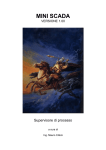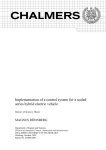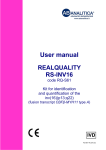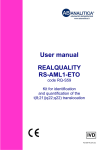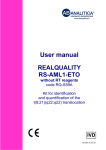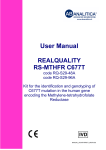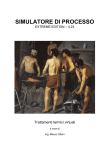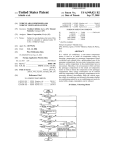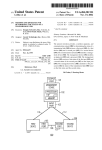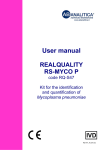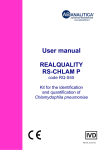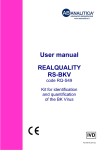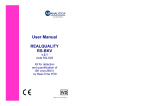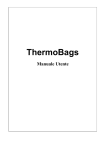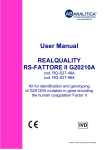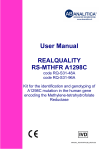Download User manual
Transcript
User manual REALQUALITY RS-WT-1 code RQ-S57 Kit for identification and quantification of the Wilm’s Tumor Gene (WT-1) expression RQ-S57-48_EN.doc 1. 1.1 PRODUCT INFORMATION 3 Intended Use 3 2. KIT CONTENT 4 3. STORAGE AND STABILITY OF THE REAGENTS 5 4. PRECAUTIONS FOR USE 5 5. SAFETY RULES 7 5.1 General safety rules 7 5.2 Safety rules about the kit 7 6. MATERIALS REQUIRED, BUT NOT PROVIDED 8 6.1 Reagents 8 6.2 Instruments 8 6.3 Materials 8 7. INTRODUCTION 9 8. TEST PRINCIPLE 10 9. PRODUCT DESCRIPTION 12 10. COLLECTION, MANIPULATION AND PRE-TREATMENT OF THE SAMPLES 13 11. PROTOCOL 13 11.1 RNA extraction 13 11.2 Reverse transcription (RT) for the cDNA synthesis 14 11.3 INSTRUMENT PROGRAMMING 11.3.1 Creation of thermal protocol 11.3.2 Plate Setup 15 15 15 11.4 AMPLIFICATION PROTOCOL 16 11.5 ANALYSIS OF THE DATA AND INTERPRETATION OF RESULTS 17 12. NORMALIZATION AND QUANTIFICATION OF MINIMAL RESIDUAL DISEASE 20 1 RQ-S57-48_EN.doc 13. TROUBLESHOOTING 21 14. DEVICE LIMITATIONS 23 15. DEVICE PERFORMANCES 23 15.1 Analytical specificity 23 15.2 Analytical sensitivity: detection limit 23 15.3 Analytical sensitivity: linearity 23 15.4 Reproducibility 24 15.5 Diagnostic specificity 25 15.6 Diagnostic sensitivity 25 15.7 Accuracy 25 16. REFERENCES 26 17. USEFUL LINKS 26 18. RELATED PRODUCTS 27 RQ-S57-48_EN.doc 2 1. PRODUCT INFORMATION 1.1 Intended Use The REALQUALITY RS-WT-1 is an IVD for identification and quantification of the Wilm’s Tumor gene (WT-1) expression, located on chromosome 11p13, by amplification of cDNA in the regions of the gene on exon 1-2. If used together with the REALQUALITY RQ-WT-1 STANDARD code RQ-58-ST kit, it allows the quantification of the WT-1 transcripts present in the sample. The Real time PCR amplification method is used in this kit, starting from c-DNA obtained by reverse transcription of the RNA extracted from human clinical samples. This in vitro diagnostic test is an auxiliary device for detection, monitoring, and reoccurrence of hematopoietic leukemia cells (above all in cases with Acute Myeloid Leukemia AML). It is recommended to use this kit as indicated in the instructions herein. The present manual refers to the following product: REALQUALITY RS-WT-1 Kit for identification and quantification of the Wilm’s Tumor gene (WT-1) expression, by Real time PCR amplification. This product is in accordance with 98/79/CE Directive (Annex III) regarding the In Vitro medical diagnostic devices (CE mark). Contains all the reagents needed for Real time amplification. Code RQ-S57-48 RQ-S57-96 Product REALQUALITY RS-WT-1 REALQUALITY RS-WT-1 3 PKG 48 test 96 test RQ-S57-48_EN.doc 2. KIT CONTENT BOX P STORE AT -30°/– 20°C DESCRIPTION TUBE (T) OR LID COLOUR LABEL 24 test 48 test 96 test Reverse transcription necessary reagents RT MIX 3 x 143 L 6 x 135 L 6 x 260 L Reverse transcriptase RT Enzyme 1 x 17 L 1 x 30 L 2 x 30 L 2X Q Real time mix 2 x 350 L 3 X 450 L 6 X 450 L MgCl2 1 x 50 L 1 X 75 L 1 X 150 L Mastermix 2X Magnesium Chloride solution Primer and probe Mix WT-1 Oligomix White 1 x 27 L 2 x 27 L 4 x 27 L Primer and probe Mix ABL Oligomix Blue 1 x 27 L 2 x 27 L 4 x 27 L RQ-S57-48_EN.doc 4 3. STORAGE AND STABILITY OF THE REAGENTS Each component of the kit must be stored according to the directions indicated on the label of of each box. In particular: Box P Store at -30°C/-20°C If stored at the recommended temperature, all test reagents are stable until their expiration date. The 2X Q Real time Mix and Oligomix are sensitive to physical state variations: it is recommended not to let the reagents undergo more than two freeze/thaw cycles. If the single test runs are limited to a small number of samples, it is recommended to aliquot the reagents. 2X Q Real time Mix and Oligomix contain fluorescent molecules: it is recommended to store these reagents away from direct light. 4. PRECAUTIONS FOR USE The kit must be used only as an IVD and handled by qualified technicians, who are well educated and trained in molecular biology techniques applied to diagnostics; Before starting the kit procedure, read carefully and completely the user manual; Keep the kit away from heating sources; One must pay particular attention to the expiration date on the label of each box: do not use any part of the kit past the expiration date; The reagents present in the kit must be considered an undividable unit. Do not divide or use different reagents from other kits or lots; All the reagents must be thawed at room temperature before use. It is recommended to do not vortex, but to mix the solutions by inverting the tube several times and then centrifuge them briefly. Prepare the reaction quickly at room temperature or work on ice or on a cooling block. 5 RQ-S57-48_EN.doc In case of any doubt about the storage conditions, box integrity or method application, please contact AB ANALITICA’s technical support at: [email protected]. During nucleic acid amplification, the technician has to take the following special precautions: Use filter-tips; Store the biological samples, the extracted RNA, cDNAs, and positive controls included in the kit and all the amplification products in different places from where amplification reagents are stored; Organize the work areas in different pre- and post-PCR units; do not share instruments and consumables (pipettes, tips, tubes, etc.) between them; Change gloves frequently; Wash the bench surfaces with 5% Sodium Hypochlorite; Keep the RNA (just extracted or that will be stored at -30°C/-20°C or 80°C, according to the time required between extraction and reverse transcription) on ice during reverse transcription preparation. RQ-S57-48_EN.doc 6 5. SAFETY RULES 5.1 General safety rules Wear disposable gloves to handle reagents and clinical samples and wash hands at the end of the procedure; Do not pipette by mouth; Since no known diagnostic method can assure the absence of any infective agents, it is a good rule to consider every clinical sample as potentially infectious and handle it as such; All devices that come in contact with clinical samples should be considered as contaminated and disposed of as such. In case of accidental spilling of the samples, clean up with 10% Sodium Hypochlorite. The materials used to clean up should be disposed in special containers for contaminated products; Clinical samples, materials and contaminated products should be disposed of after decontamination: immerse in a solution of 5% Sodium Hypochlorite (1 volume of 5% Sodium Hypochlorite solution for every 10 volumes of contaminated fluid) for 30 minutes; OR autoclave at 121°C for at least 2 hours (NOTE: do not autoclave solutions containing Sodium Hypochlorite!!). 5.2 Safety rules about the kit The risks for the use of this kit are related to the single components. Dangerous components: none. The Material Safety Data Sheet (MSDS) of the device is available upon request. 7 RQ-S57-48_EN.doc 6. MATERIALS REQUIRED, BUT NOT PROVIDED 6.1 Reagents Reagents for density gradient separation of mononucleated cells (Ficoll); RNA extraction reagents; Dnase- and Rnase-free sterile water; Distilled water; REALQUALITY RQ-WT-1 STANDARD code RQ-58-ST (for quantitative analysis). 6.2 Instruments Laminar flow cabinet (its use is recommended while preparing the amplification mix to avoid contamination; it would be recommended to use another similar laminar flow cabinet to add the extracted DNA and standard solutions); Micropipettes (range: 0.5-10 µL; 2-20 µL; 10-100 µL; 20-200 µL; 1001000 µL); Microcentrifuge (max 12-14,000 rpm); Plate centrifuge (optional); Thermalcycler (for reverse transcription); Real time amplification instrument. The kit was standardized on Applied Biosystems 7500 Fast Dx, 7300, StepOnePlus Real-Time PCR System (Applied Biosystems); the kit can be utilized on instruments that use 25 μL of reaction volume and can detect the FAM fluorescence correctly. For further information on instrument compatibility of the kit, please contact AB ANALITICA’s technical support. 6.3 Materials Talc-free disposable gloves; Disposable sterile filter-tips (range: 0.5-10 µL; 2-20 µL; 10-100 µL; 20200 µL; 100-1000 µL); Sterile DNase and RNase free tubes (for reverse transcription); 96-well plates for Real time PCR and the optical adhesive film or 0.1-0.2 mL tubes with optical caps. RQ-S57-48_EN.doc 8 7. INTRODUCTION The leukemia and lymphoma study leaded to a better comprehension of the cellular and molecular mechanisms involved in many neoplastic pathologies, thanks to the easy finding and sampling of malignant leukemic cells present in the blood, despite the solid tumor's ones which are sometimes difficult to be collected without the use of invasive methods. The WT-1 gene is localized on chromosome 11p13, encode for a transcription factor containing four zinc-finger domains in the C-terminal part and it was initially identified for its role in the pathogenesis of Wilm's tumor (Sugiyama et al., 2001). Moreover, it has been demonstrated that WT-1 gene is highly expressed in most of hematopoietic tumor pathologies (Sugiyama et al., 2001; Liu-Yin et al., 2002): in samples of peripheral or bone marrow blood of healthy subjects, indeed, WT-1 shows low expression levels; such levels are increased, instead, in a significant way, in patients with acute myeloid leukemia (AML) and acute lymphoblastic leukemia (ALL), both in pediatric and adult age, even in subjects with chronic leukemia. The scientific community thought to establish a cut-off for the sample definition at high (subjects with disease) and low (healthy people) expression of WT-1 (Cilloni D et al., Haematologica, 2008). Different studies highlighted the importance of the monitoring of the Minimal Residual Disease (MRD), by quantitative Real time PCR, in order to highlight specific molecular markers of the disease (for example the fusion transcripts BCR-ABL and AML1-ETO or mutations as NPM1): this enables for the individuation of patients at high-risk relapse, for whose the precocious therapeutic intervention is extremely important (Freeman et al., 2008). Since for an half of the AML patients is not possible to detect a leukemiaspecific target, it is extremely important to develop alternative approaches so that the MRD is applicable to a large number of patients. A lot of studies demonstrated the utility of quantitative Real time PCR in order to monitor the expression levels of WT-1 gene as relative indication for the leukemic diagnosis, for aggressiveness level of the disorder and to the response to the pharmaceutical treatment (Freeman et al., 2008). 9 RQ-S57-48_EN.doc 8. TEST PRINCIPLE PCR method (Polymerase Chain Reaction) was the first method of DNA amplification described in literature (Saiki RK et al., 1985). It can be defined as an in vitro amplification reaction of a specific part of DNA (target sequence) by a thermostable DNA polymerase. This technique was shown to be a valid and versatile molecular biology instrument: its’ application contributed to a more efficient study of new genes and their expression and it brought to a revolution in the laboratory diagnostic and forensic medicine field. The REAL TIME PCR technology represents an advancement of the basic PCR technique; it allows to measure the number of DNA molecules amplified during the exponential amplification phase. The amplicon monitoring is essentially based on the labeling of the primers and probes, or of the amplicons themselves, with fluorescent molecules. In the first case, the Fluorescence Resonance Energy Transfer (FRET) among the two fluorophores, or other mechanisms which lead to fluorescence emission and involve a fluorophore and a non-fluorescent quencher (molecular beacon, scorpion primer, etc) are used. The mechanism that determines the fluorescence emission is based on the presence of a quencher molecule, located in proximity of a reporter molecule, that blocks the fluorescence emission by the reporter. When the quencher is separated from the reporter, the latter emits fluorescence. The real time detection of such fluorescence is accomplished by means of a thermalcycler equipped with fluorescence detector. Each amplification cycle will release a certain amount of fluorescence into the solution; the cycle at which the amplification generates the minimal amount of fluorescence needed to overcome the basal noise threshold is called the “cycle threshold” (Ct). By intuition, the higher the starting concentration of the target nucleic acid, the sooner the amplification will reach the cycle threshold. The Ct value is reached during the exponential phase of the amplification reaction, where the amplification reaction is still proportional to the number of target molecules in the solution. The starting concentration of the unknown samples is determined by comparison of the Ct value of each sample with the Ct value of a standard curve acquired at known concentration (Figure 1). RQ-S57-48_EN.doc 10 Figure 1: Creation of a standard curve starting from the standard Ct values at known concentration. Main advantages of the Real time PCR technique, compared to the conventional amplification techniques, are for example the possibility to execute a semi-automated analysis in which the time needed for the visualization of the amplicons is eliminated; and the absence of the postamplification sample manipulation that reduces the possible contamination phenomena. 11 RQ-S57-48_EN.doc 9. PRODUCT DESCRIPTION The REALQUALITY RS-WT-1 code RQ-S57, used with the REALQUALITY RS-WT-1 STANDARD code RQ-S58-ST, allows the identification and quantification of Wilm's Tumor (WT-1) gene expression, localized on chromosome 11p13, by c-DNA amplification of the gene regions on exons 1-2. Such quantification is obtained by the construction of a four-point standard curve for WT-1 and, in parallel, for ABL genes. In fact, starting from the c-DNA itself but in a separated PCR reaction, the sequence of housekeeping gene ABL is amplified; such amplification, in addition to be a mark for the quantification and normalization, allows to evaluate both the extracted RNA suitability, the following retro-transcription reaction and the possible presence of PCR reaction inhibitors. This valid tool helps the user to recognize possible false negative results. ABL gene amplification is made separately from WT-1 amplification, because experimental evidences demonstrate that a competition between the two targets can occur in samples with a low number of WT-1 transcripts, and sometimes it ends up to heavily disadvantage the specific translocation transcript amplification, with the possibility to have false negative. The given positive controls are made by a DNA fragment with the target region of interest, and they are not dangerous for the user. For amplification reaction preparation, a ready-to-use Mastermix is supplied, containing all the reagents needed, with the exception of the Oligomix, and in particular: ROX™, an inert colorant in which the fluorescence does not undergo changes during the amplification reaction; it is used to normalize eventual differences between wells caused by artifacts from pipetting errors or instrument limitations; dUTP/UNG system prevents contaminations from previous amplifications, since it removes residual uracil incorporated in the molecule of single or double stranded DNA. NOTE: The kit was developed in accordance with the Europe Against Cancer guidelines (Gabert et al., Leukemia 2003) and with the international recent recommendations (Branford et al., Leukemia 2006). RQ-S57-48_EN.doc 12 10. COLLECTION, MANIPULATION AND PRETREATMENT OF THE SAMPLES The analysis of the WT-1 expression is performed starting from whole peripheral or bone marrow blood. Sample collection must follow all the usual sterility precautions. Blood must be treated with EDTA. Other anticoagulation agents, as heparin, are strong inhibitors of TAQ polymerase and so they could alter the efficiency of the amplification reaction. Fresh blood can be stored at +2°C/+8°C if processed in 4 hours after the withdrawal: thus it is necessary to proceed with the mononucleate cells separation by density gradient centrifugation (Ficoll – reagent not included in the kit). From the pellet of lymphocytes obtained as such, is possible to proceed directly with RNA extraction; otherwise, the cell pellet may be conserved at -80°C until the RNA extraction, better if preserved in a buffer containing RNAse enzyme inhibitors (i.e.: RLT buffer -QIAGEN- or Trizol). 11. PROTOCOL 11.1 RNA extraction The product was validated using the RNeasy Mini kit (QIAGEN, Hilden, Germany). For use, follow the user manual of the manufacturer. However, the device is suitable for most diffused manual or automatic RNA extraction methods. For any further information on device compatibility with different extraction methods, please contact AB ANALITICA’s technical support. Please follow the instructions below regarding the quantity of RNA to be used for the reverse transcription reaction (about 1µg). 13 RQ-S57-48_EN.doc 11.2 Reverse transcription (RT) for the cDNA synthesis Attention: before starting the reverse transcription procedures, it is recommended to use an ice container and to thaw one or more RT Mix aliquots (depending on the number of analyzed samples). Once thawed, the RT Mix must be mixed well by inverting the tube several times (do not vortex!) and, after a brief centrifuge, must be stored on ice until use. For each sample, add to a sterile DNase and Rnase free tube (see paragraph 6.3): Extracted RNA 5 μL* *NOTE: The 5 μL amount indicates the void volume available for the reaction. The appropriate amount of RNA to be used for reverse transcription is about 1 μg; if the RNA is more concentrated, it is necessary to dilute it properly with DEPC H2O. Insert the tubes in the thermalcycler and program the following thermal profile: 1 cycle 70°C, 10 min Next, place the tubes on ice immediately, for at least 5 minutes. Add 14.5 μL of RT Mix and 0.5 μL of RT Enzyme, mix by pipetting, centrifuge briefly and incubate in a thermalcycler programmed as below: 20°C, 10 min 1 cycle 42°C, 45 min 99°C, 3 min 4°C, 5 min Once the cycle ends, add 30 μL of sterile water to each retrotranscribed sample. The diluted cDNA can be stored at +2°C/+8°C for short period of time (maximum one week) or at -20°C/-30°C for longer periods of time. NOTE: the cDNA obtained can be used both for the WT-1 translocation amplification and for the housekeeping ABL gene amplification. RQ-S57-48_EN.doc 14 11.3 INSTRUMENT PROGRAMMING 11.3.1 Creation of thermal protocol Set the following thermal profile: Cycle Repeats Step Time (°C) 1 2 1 1 1 1 2:00 10:00 50.0 95.0 3 45 1 00:15 95.0 2* 01:00 60.0 UNG Activation Taq Activation Amplification cycles * Fluorescence collection step 11.3.2 Plate Setup Define the dilution of the WT-1 and ABL standard in the interval from 102 to 105 copies. Mark the grid of the new plate with the position of the negative control (NTC), standards (STD) and samples (Unknown), making sure the position is the same as on the plate and identify each sample with its name. NOTE: it is recommended to amplify both samples and positive/negative controls and standards in duplicate. Select and activate the FAM fluorophore, and NONE as quencher. Pay attention that, for the instruments that require it, the detection of the fluorescence of the fluorophore ROX™ corresponds to each position. ROX™ is an inert colorant in which the fluorescence does not undergo changes during the amplification reaction; on instruments that use ROX (Applied Biosystems, Stratagene, etc.), it is used to normalize eventual differences between wells caused by artifacts due to pipetting errors or instrument limitations. Record, where required, that the final reaction volume is 25 μL. 15 RQ-S57-48_EN.doc 11.4 AMPLIFICATION PROTOCOL Once thawed, mix the reagents by inverting the tubes several times (do not vortex!), then centrifuge briefly. Prepare the reaction mix rapidly at room temperature or work on ice or on a cooling block. Try, when possible, to work in area away from direct light. Prepare, as described below, a mix sufficient for all the samples to be tested, counting also for the positive and negative control, in the latter H2O is added instead of DNA, and when calculating the volume, consider an excess of at least one reaction volume. WT-1 Amplification Reagent 2X Q Real time Mix WT-1 Oligomix MgCl2 H2O Total Volume 1 Reaction 12.5 μL 1.0 μL 0.5 μL 6.0 μL 20.0 μL ABL Amplification Reagent 2X Q Real time Mix ABL Oligomix MgCl2 H2O Total Volume 1 Reaction 12.5 μL 1.0 μL 0.5 μL 6.0 μL 20.0 μL Mix by inverting the tubes, in which the mix was prepared in, several times. Then centrifuge briefly. Pipette 20 μL of the mix in each well of the plate. Add to each well, in the correct positions, 5 μL of cDNA or 5 μL of positive control, provided in the kit. RQ-S57-48_EN.doc 16 Always amplify a negative control together with the samples to be analyzed (add sterile water instead of extracted DNA to the corresponding well) both for the WT-1 and the ABL Mix. Hermetically seal the plate by using an optical adhesive film or appropriate sealer. Make sure that there are no air bubbles in the bottom of the wells and/or centrifuge the plate at 4000 rpm for about 1 minute. Load the plate on the instrument making sure to position it correctly and start the amplification cycle. 11.5 ANALYSIS OF THE DATA AND INTERPRETATION OF RESULTS At the end of the reaction, view the graph in logarithmic scale (Figure 2). Analyze WT-1 and ABL graphs and quantification results separately. Position the Threshold, by choosing the position in which the Correlation Coefficient (R2) and the slope of the curve values are the closest possible to 1 and -3.33, respectively (Figure 3). Results are considered acceptable, when the efficiency of the amplification is between 85 – 110% (slope approximately -3.75 - -3.10) and the Correlation Coefficient value is not less than 0.990. 17 RQ-S57-48_EN.doc Fig. 2: Analysis of the post run data: amplification graph of WT-1 in logarithmic scale view on Applied Biosystems 7300 Real Time PCR System with SDS software version 1.2.3. Fig. 3: Analysis of the post run data: standard curve visualization on Applied Biosystems 7300 Real Time PCR System with SDS software version 1.2.3. RQ-S57-48_EN.doc 18 NOTE: If one works in duplicates, it is important that the replicates do not produce a difference of the Ct (∆Ct) > 1.5 . For ABL values, samples with ABL Ct corresponding to the copy number that is inferior to the minimum limit of the linearity range (see paragraph 15 “Device performances”) must be excluded from the analysis. The International scientific community also defined an ABL Ct range within which the samples can be considered adequate for the analysis (ABL Ct 21.8 - 29.4, J Gabert et al. Leukemia 2003). This is of particular importance when studying the Minimal Residual Disease in samples with a low WT-1 copy number: it allows to be sure that the obtained results is correct and to exclude the possibility that a low copy number of WT-1 is due to low cells number in the samples. 19 RQ-S57-48_EN.doc 12. NORMALIZATION AND QUANTIFICATION OF MINIMAL RESIDUAL DISEASE The WT-1 and ABL standard curves allow to transform the Ct values obtained for unknown samples in WT-1 (WT-1 CN) and ABL (ABLCN) copy numbers. The normalized copy number (NCN) of the WT-1 transcript is defined as the ratio between the WT-1 CN and ABLCN copy number: NCNWT-1 = (WT-1CN / ABLCN) x 104 The Minimal Residual Disease (MRD) is expressed as the ratio between the WT-1 normalized copy number at the follow-up (FUP) and the WT-1 normalized copy number at the time of the diagnosis (DX): MRD = NCNFUP/ NCNDX In case of the follow-up samples, the sensitivity (SENSv) of the experiment must be calculated in order to determine the clinical validity of the obtained results: SENSv = ABLCN,DX/ (ABLCN,FUP x WT-1CN,DX) RQ-S57-48_EN.doc 20 13. TROUBLESHOOTING Absence of amplification signal for positive controls/standards and samples The instrument was not programmed correctly – Repeat the amplification paying attention of the instrument programming; pay particular attention to the thermal profile, the selected fluorophores and the correspondence between the plate protocol and the plate itself. The amplification mix was not prepared correctly – Prepare a new amplification mix paying attention to follow the instructions reported in paragraph 11.4. The kit was not stored properly or it was used past the expiration date – Check both the storage conditions and the expiration date reported on the label; use a new kit if needed. Weak amplification signal intensity for positive controls/standards Positive controls/standards were stored incorrectly and have degraded – Store the positive controls/standards correctly at +2°C/+8°C; – Do not use the positive controls/standards past the expiration date. The reaction mix does not function correctly – Make sure to store the 2X Q Real time Mix and Oligomix correctly at -20°C/-30°C. Avoid unnecessary freeze/thaw cycles. Amplification signal of ABL very delayed or absent in the extracted samples The extracted RNA is not suitable for amplification or a problem may have occurred during the reverse transcription reaction and the amplification reaction was inhibited – Make sure to perform the extraction of nucleic acids correctly 21 RQ-S57-48_EN.doc – If an extraction method uses wash steps with solutions containing Ethanol, make sure no Ethanol residue remains in the DNA sample; – Use the extraction methods suggested in paragraph 11.1; – During reverse transcription reaction, check that the reverse transcriptase enzyme has been pipette in the tube, by looking for the drop formed by the enzyme on the tube wall after being added to the mix, then centrifuge briefly; – Follow standard procedures for minimizing RNA degradation: use RNase free plastic lab ware and work on ice during the reverse transcription reaction. For any further problems, please contact AB ANALITICA’s technical support at: [email protected], fax (+39) 049-8709510, or tel. (+39) 049761698). RQ-S57-48_EN.doc 22 14. DEVICE LIMITATIONS The kit can have reduced performances if: the clinical sample is not suitable for this analysis (sampling and/or storage error, i.e. heparin-treated blood or use of other unsuitable anticoagulants); the treatment of the starting sample was not performed as indicated in the paragraph 10; the kit was not stored correctly. 15. DEVICE PERFORMANCES 15.1 Analytical specificity The specificity of the REALQUALITY RS-WT-1 code RQ-S57 kit is guaranteed by an accurate and specific selection of primers and probes, and also by the use of stringent amplification conditions. The alignment of primers and probes in the most important databanks shows the absence of non-specific pairing. 15.2 Analytical sensitivity: detection limit The analytical sensitivity limit of REALQUALITY RS-WT-1 kit was defined by the amplification test of 8 dilution replicates from the last point of the quantification standard conducted in at least 3 consecutive runs. The results are reported in Table 1. 15.3 Analytical sensitivity: linearity The linearity of the assay was determined using a quantification standard panel. The analysis of the data obtained by linear regression have demonstrated that the test presents for WT-1 and for ABL a linear response for all the panel point (R2>0.99). The results of the analysis are reported in Table 1. 23 RQ-S57-48_EN.doc 15.4 Reproducibility A 50 transcript copies/L dilution (corresponding to a final amount of 250 transcript copies/reaction) of the quantification standard was amplified in eight replicates in the same run, in order to determine the intra-assay variability (variability among the replicates of a certain sample in the same assay). The intra-assay variability coefficient of the method, in respect to the Cycle threshold (Ct), for WT-1 and ABL is reported in Table 1. The last point of the quantification standard (20 transcript copies/L corresponding to 100 transcript copies/reaction) was amplified in duplicates in three consecutive runs in order to determine the inter-assay variability (variability of the replicates of the same sample in different runs). For each run, the variability coefficient was calculated from the Ct of the samples. The inter-assay variability coefficient for WT-1 and ABL was calculated from the average of the variable coefficients in each experiment performed and is reported in Table 1. ABI 7500 Fast Dx Table 1 Detection Limit WT-1 (copies/reaction) Linear Range (copies/reaction) Intra-assay Variability Inter-assay Variability RQ-S57-48_EN.doc StepOne Plus ABI 7300 10 5 (100% positive) (100% positive) 10 – 105 ABL WT-1 10 - 106 ABL 0.508% 0.633% 0.345% WT-1 0.283% 0.343% 1.368% ABL 0.916% 0.669% 0.454% WT-1 0.328% 0.158% 0.334% 24 5 – 106 15.5 Diagnostic specificity A significant number of samples negative for WT-1 were tested simultaneously with the REALQUALITY RS-WT-1 kit and another CE IVD or reference method. From the obtained results, the diagnostic specificity of this device was calculated to be 100%. 15.6 Diagnostic sensitivity A significant number of samples positive for the WT-1 were tested simultaneously with the REALQUALITY RS-WT-1 kit and another CE IVD or reference method. From the obtained results, the diagnostic sensitivity of this device was calculated to be 97%. 15.7 Accuracy This value was calculated by the number of correct amplifications over the total number of executed amplifications. The REALQUALITY RS-WT-1 device has an accuracy of 98.4%. 25 RQ-S57-48_EN.doc 16. REFERENCES Cilloni D et al. Haematologica 93(6):921-924, 2008. Freeman SD et al. Semin Oncol 35(4):388-400, 2008. Gabert J, Beillard E, et al. Leukemia 17(12):2318-57, 2003. Liu Yin JA. Best Pract Res Clin Haematol 15(1):119-35, 2002. Saiki RK, S Scharf, F Faloona, KB Mullis, GT Horn, HA Erlich and N Arnheim, Science 230, 1350-1354, 1985. Sugiyama H. Int J Hematol 73(2):177-87, 2001. Van der Velden VH et al. Leukemia 17, 1013-1034, 2003. van Dongen JJ et al. Lancet 352, 1731-1738, 1998. van Dongen JJ, Maclntyre EA, Gabert JA et al. Leukemia12, 1901-1928, 1999. Verfaillie CM. Biology and therapy of chronic myelogenous leukaemia vol 12, num 1, 1998. 17. USEFUL LINKS www.hematology.org www.bloodjournal.org www.bloodline.net www.haematologica.it www.il-st-acad-sci.org/data6.html http://medocs.ucdavis.edu/IMD/420A/dib/index.htm http://web.tiscali.it/ematologia www.ematologia-italia.net/frame_b.htm www.simti.it http://stemcells.alphamedpress.org www.blacksci.co.uk/uk/society/bsh RQ-S57-48_EN.doc 26 18. RELATED PRODUCTS REALQUALITY RQ-WT-1 STANDARD: Quantified and ready-to-use quantification standard for WT-1. Code RQ-58-ST Product REALQUALITY RQ-WT-1 STANDARD 27 PKG 4 x 60 µL WT-1 4 x 60 µL ABL RQ-S57-48_EN.doc RQ-S57-48_EN.doc 28 AB ANALITICA srl Via Svizzera 16 - 35127 PADOVA, (ITALY) Tel +39 049 761698 - Fax +39 049 8709510 e-mail: [email protected]
































